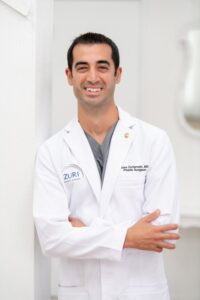MIAMI, FL, UNITED STATES, February 14, 2023 /EINPresswire.com/ — Let’s face it. Advances in aesthetic plastic surgery techniques and technology, including microneedling and intense pulsed light therapy, are making skin rejuvenation and contouring of face, neck, and body much safer and more effective, according to noted plastic surgeon Dr. Alexander Zuriarrain1.Particularly noteworthy are the recent development of two new aesthetic procedural systems — Morpheus83, which combines adjustable radiofrequency with microneedling, and the Lumecca Intense Pulsed Light Therapy work station. “Their names may sound interstellar, but they are down-to-earth, advanced technologies, enabling surgeons to achieve far-better cosmetic results,” says Dr. Zuriarrain, who is based in Miami and specializes in aesthetic and plastic surgery procedures.
“We have become a nation obsessed with aging backwards by restoring the youthful structure and luster of our skin. Improved, energy-based technologies — such as the laser; high intensity light, microwave, and ultrasound; and radiofrequency — are quickly gaining popularity as minimally invasive cosmetic tools for tightening skin, reducing adipose (fat) tissue, smoothing out wrinkles, and eliminating unsightly skin blotches, marks, and hyperpigmentation,” he states.
Experts note that systems like the Morpheus8 and Lumecca Pulsed Light Therapy – both manufactured by InMode — employ, and, in some cases, combine several of the newest cosmetic approaches while giving plastic and aesthetic surgeons much greater precision and control during procedures.
For example, the Morpheus8 offers microneedling with radiofrequency that can be customized and adjusted to various depths of skin penetration in order to achieve maximum results, Dr. Zuriarrain explains. “Unlike some of the other technologies, the Morpheus8 also can be used on the face, neck, and body, and is effective for all skin types and tones.”
Microneedling strengthens the skin’s underlying structure by pricking the skin using small needles and stimulating production of collagen, elastin, and skin tissue cells, Dr. Zuriarrain explains. Radiofrequency (RF), on the other hand, tightens skin “by thermal healing of the reticular dermis” (area that cannot be reached by microneedling), thus “triggering a healing cascade [that] leads to collagen formation,” say authors of a 2019 article in the Aesthetic Surgery Journal (https://pubmed.ncbi.nlm.nih.gov/30958550/). In fact, radiofrequency has “evolved to meet rising demand” and its use for cosmetic purposes is increasing at the rate of about 10 percent a year, these scientists contend.
Collagen is a protein that serves as the primary structural component for connective tissue, including the skin. As part of the aging process, the body’s production of collagen decreases, causing skin to lose elasticity and become thinner and drier leading to wrinkle formation and sagging.
Physicians writing in an August 2022 issue of the Journal of Cosmetic Dermatology (https://onlinelibrary.wiley.com/doi/10.1111/jocd.15231) conclude “the adjustable depth and microneedle pin configurations available with the InMode Morpheus8 allow clinicians to address varied tissue targets and regions of concern on the face. The ease of use for practitioners, minimal post-treatment recovery time, and enduring results make fractional RF microneedling an increasingly attractive option for patients desiring minimally invasive options.”
Meanwhile, Dr. Zuriarrain describes the intense pulsed light therapy (IPL), or photothermolysis, generated by the Lumecca system, as “quite effective” for removing age spots; hyperpigmentation and pigmented lesions like spider veins, port-wine stains, and vascular lesions; and rosacea and for repairing sun-damaged areas of skin. The technology works best on skin of lighter tones, he says.
Dr. Zuriarrain calls “unprecedented” the demand for minimally invasive cosmetic procedures using the Morpheus8 and similar tools. The demand is particularly pronounced among younger adults who want to avoid the downtime and scarring risks of traditional surgeries or who are not candidates for surgery, such as patients with recurrent skin laxity issues.
Building self-confidence, looking younger, and improving appearance for video calls and Zoom meetings are among the key reasons for seeking cosmetic procedures. Dr. Zuriarrain’s experience is that patients over age 45 are the ones most likely to request facelifts and eyelid surgery, while those under 30 oftentimes are requesting lip augmentation.
For those who are considering cosmetic procedures, Dr. Zuriarrain offers these tips:
• Before doing anything, carefully consider why you want to undergo aesthetic surgery, or facial, neck, or body modeling and contouring. What do you hope to accomplish? Talk to a cosmetic or plastic surgery specialist first to determine whether your goal is even achievable.
• Keep expectations low – or, at least, reasonable. Cosmetic procedures can achieve highly desirable results but are not miraculous. Years of aging and sun damage cannot be undone in a few aesthetic surgery sessions, no matter how high-tech the surgeon’s tools.
• Take all the necessary precautions to protect your skin in the days and weeks following cosmetic procedures. That means stay out of the sun as much as possible.
• Follow a healthy lifestyle. Eat nutritiously, get regular exercise, and avoid smoking and overconsumption of alcohol.
“Finally, understand that nothing is forever. No matter how great the results of any cosmetic procedure, the aging process will continue to do its work and eventually the skin you have had smoothed and tightened will wrinkle, sag, and even develop age spots and blotches again,” Dr. Zuriarrain advises.
Bio: Alexander Zuriarrain MD is a quadruple-board-certified plastic surgeon who specializes in aesthetic procedures of the face and body. He is the founder of Zuri Plastic Surgery2 in Miami, FL. www.zuriplasticsurgery.com

